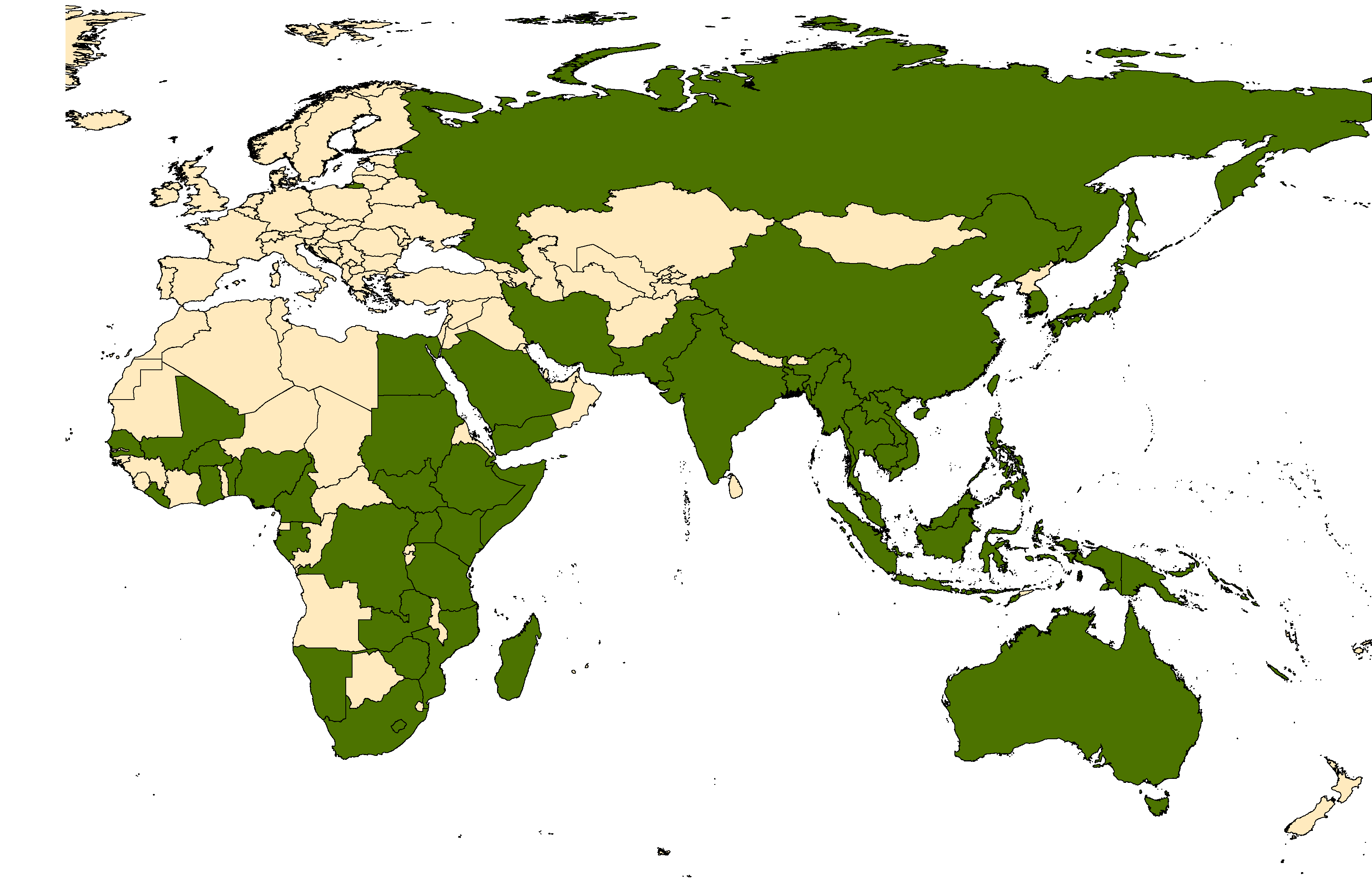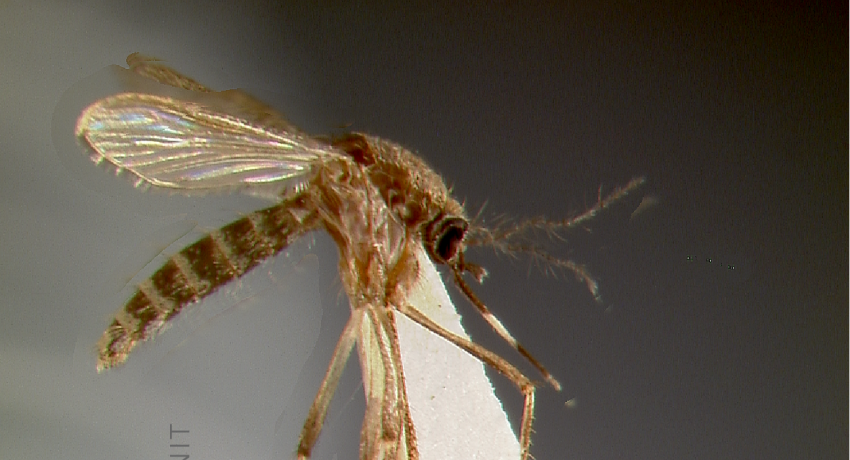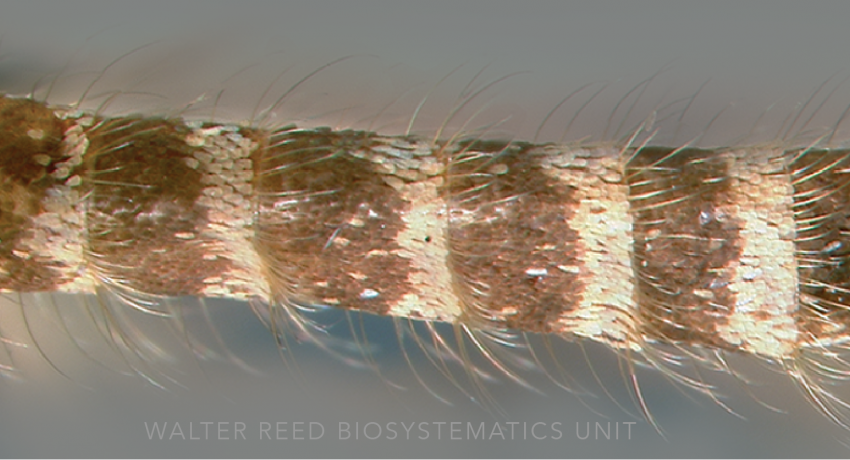AFROTROPICAL, AUSTRALASIAN & ORIENTAL REGIONS
Etymology: not stated [double banded (L, Gr); probable reference to proboscis with two bands]
Culex bitaeniorhynchus is the nominotypical member of the Bitaeniorhynchus Complex, which also includes Cx. infula Theobald, Cx. longicornis Sirivanakarn, Cx. luzonensis Sirivanakarn, Cx. pseudosinensis Colless and Cx. selangorensis Sirivanakarn. Culex bitaeniorhynchus is found in tropical and sub-tropical zones of the Afrotropical, southern Palearctic and Indomalayan Regions as well as the mainland and islands of the Southeast Asian and Australasian regions.
Type locality: Travancore, India
Type depository: Natural History Museum, London, England, United Kingdom (NHMUK)
DIAGNOSTIC CHARACTERS (Click photos to view; mouse over and click large photo to zoom in.)
ADULT (not illustrated): Head: Proboscis with median pale band and two dorsolateral pale spots at labellum. Thorax: Acrostichal setae present; lower mesepimeral setae absent. Abdomen: With distinct apical bands of pale-yellow scales. Wing: With intermixed pale and dark scales. Leg: Fe-I–III and Ti-I–III without rows of pale spots; Ta-I–III with basal pale bands.
LARVA (not illustrated): Head: Setae 2,3-A inserted apically on antenna; antennal spicules absent or sparse; seta 1-C slender; no demarcation between dorsal apotome and median labral plate; dorsomentum with fine serrations. Terminal segments: With 4–7 comb scales and 7 pecten spines; seta 1-S with 4 pairs of 1–4 branched tufts, positioned laterally or posterolaterally.
TAXONOMIC KEYS
LaCasse & Yamaguti 1950
Harbach 1988
Lee et al. 1989a
Darsie & Pradhan 1990
Jupp 1996
Rattanarithikul et al. 2005
![]()
WRBU – Culex (Ocu.) - Australasian Region – Larva
![]()
WRBU – Culex (Ocu.) - Indomalayan Region – Adult
![]()
WRBU – Culex (Ocu.) - Indomalayan Region – Larva
![]()
WRBU – Culex (Ocu.) - Oriental Region – Adult
![]()
WRBU – Culex (Ocu.) - Oriental Region – Larva
![]()
WRBU – Culex (Ocu.) - Eastern Palearctic Region – Adult
![]()
WRBU – Culex (Ocu.) - Eastern Palearctic Region – Larva
Exemplar DNA sequences
Cx. bitaeniorhynchus COI: AB738227–28, AB738237, AB738254, DQ154162, HQ398898-99, JQ728034, JQ728200, JQ728349, KF406792–95, KT358430–32, KU187022, KU380407
BIONOMICS
Immatures
Immature Cx. bitaeniorhynchus occupy ground-water habitats in partial or full sunlight, including swamps, rice fields, marshy depressions, irrigation ditches, and ponds. Immature habitats are associated with the presence of Spirogyra (water silk) algal mats, which are the primary food source for the larva, and offer protection from predation.
Adults
The host preferences of vary markedly by region. Although primarily bird-feeders, they opportunistically feed on a wide-variety of non-avian hosts, including people, cows, pigs, and dogs. In Malaysia, New Guinea and Vietnam, Cx. bitaeniorhynchus ferociously attack man. However, populations in Africa, Southwestern Asia, and India are wholly zoophilic. Peak biting occurs just after sunset and females are active throughout the night.
DISTRIBUTION NOTES
Australia, Bangladesh, Benin, Burkina Faso, Cambodia, Cameroon, Democratic Republic of the Congo, Djibouti, Egypt, Ethiopia, Gabon, Gambia, Ghana, Hong Kong, India, Indonesia, Iran, Japan, Kenya, Laos, Lesotho, Liberia, Madagascar (includes Glorioso & Juan De Nova Is), Malaysia, Mali, Micronesia (Wake Island), Mozambique, Myanmar, Namibia, Nepal, New Caledonia, Nigeria, Pakistan, Palau, Papua New Guinea, People's Republic of China, Philippines, Russia, Saudi Arabia, Senegal, Singapore, Solomon Islands, Somalia, South Africa, South Korea, Sri Lanka, Sudan & South Sudan, Taiwan, Tanzania, Thailand, Uganda, Vietnam, Yemen, Zambia, Zimbabwe.

WRBU VECTOR HAZARD REPORTS
None; View other WRBU Vector Hazard Reports
Available GIS Models:
Cx_bitaeniorhynchus_Nyari_1 Global
IMPORTANT REFERENCES (full citations below)
Giles 1901a: 607 (A)
Barraud 1923c (L*)
Barraud 1934: 391 (M*, F, L*)
Bohart & Ingram 1946b: 77 (M*, F, L*; bionomics, distribution, taxonomy)
LaCasse & Yamaguti 1950 (M*,F*, P*, L*; taxonomy, keys, bionomics, distribution)
Asanuma & Nakagawa 1953: 93 (P*)
Hara 1957: 55 (F*)
Belkin 1962: 215 (M*, F, P*, L*)
Bram 1967b: 258 (M*, F*, P*, L*; bionomics, distribution, taxonomy)
Aslamkhan 1971b (distribution; Pakistan)
Basio 1971b: 54 (M*; bionomics)
Lotfi 1973: 206 (distribution)
Sirivanakarn 1973c: 235 (M*, F*, P, L; taxonomy)
Gutsevich et al. 1974: 367 (M*, F, L*)
Baisas 1974: 88 (M*, F*, P*, L*; taxonomy, bionomics, distribution; Philippines)
Tanaka et al. 1975c: 220 (distribution)
Rickenbach et al. 1976: 96 (distribution)
Service 1976a: 262 (distribution)
Sirivanakarn 1976: 65 (M*, F*, P*, L*; distribution)
Rodhain et al. 1977 (distribution)
Tanaka et al. 1979: 173 (M*, F*, L*; as Culex (Culex))
Harbach 1988: 101 (M*, F, P*, L*; taxonomy, keys, bionomics, distribution)
Lee et al. 1989a: 102 (F key, taxonomy, bionomics, distribution, review)
Darsie & Pradhan 1990 (F, L; taxonomy, keys, bionomics, distribution; Nepal)
Jupp 1996 (M*, F*; key)
Tanaka 2004b: 221 (P*, L mandible*, maxilla*; from subgenus Culex)
Abdel-Mohsin 2004: (distribution; Saudi Arabia)
Rattanarithikul et al. 2005 (F*, L*; bionomics, distribution, keys)
CURRENT SYNONYMS
syn. ager Giles
1901b: 196 (F; Taeniorhynchus). Type locality: Madras Presidency, India (NHMUK). References: Townsend 1990: 38 (type information).
syn. ethiopicus Edwards
1912c: 30 (A*, as ager var.). Type locality: [Bole, Northern Territories,Ghana] (NHMUK). References: Edwards 1941: 291 (M*, F*, tax., from syn. with bitaeniorhynchus), 415 (P*); Hopkins 1952: 282 (L*); Harbach 1988: 101 (synonymy); Jupp 1996 (M*, F*; key).
syn. karatsuensis Mochizuki
1913: 28 (M*, F*, E). Type locality: Karatsu, Kyushu, Japan (LU).
syn. abdominalis Taylor
1913: 53 (F*; Culicelsa). Type locality: Ayr & Townsville, Queensland, Australia (NE).
CITED REFERENCES
Abdel-Mohsin, M.O.A. (2004). First record of three Afrotropical Culex species (Diptera: Culicidae) in Saudi Arabia. Annals of Medical Entomology, 13(1–2), 1–9.
Asanuma, K., & Nakagawa, H. (1953). Morphological and taxonomic studies of some mosquito pupae belonging to the genera Aedes and Culex from Japan, with special regards to the chaetotaxy. Miscellaneous Reports of the Research Institute for Natural Resources, 86–98.
Aslamkhan, M. (1971b). The mosquitoes of Pakistan I. A checklist. Mosquito Systematics, 3(4), 147–159.
Baisas, F. E. (1974). The mosquito fauna of Subic Bay Naval Reservation, Republic of the Philippines. San Francisco: Headquarters, First Medical Service Wing (PACAF), San Francisco.
Barraud, P. J. (1923c). A revision of the culicine mosquitoes of India. Part III. Notes on certain Indian species of the genus Finlaya, Theo. and descriptions of new species. Indian Journal of Medical Research (Calcutta), 11(1), 214–219.
Barraud, P. J. (1934). The fauna of British India, including Ceylon and Burma. Diptera. Vol. 5. Family Culicidae, tribes Megarhinini and Culicini (Vol. 5). London: Taylor and Francis.
Basio, R. G. (1971b). The mosquito fauna of the Philippines (Diptera, Culicidae). Manila: National Museum of the Philippines. 198pp.
Belkin, J.N. (1962). The mosquitoes of the South Pacific (Diptera, Culicidae) (Vols. 1 &2). Berkeley, California: University of California Press.
Bohart, R.M., & Ingram, R.L. (1946b). Mosquitoes of Okinawa and islands in the Central Pacific. In United States NAVMED (Bureau of Medicine and Surgery, Navy Department) (pp. 110). Washington.
Bram, R.A. (1967b). Contributions to the mosquito fauna of Southeast Asia. II. The genus Culex in Thailand (Diptera: Culicidae). Contributions of the American Entomological Institute, 2(1), 1–296.
Edwards, F.W. (1912c). A synopsis of the species of African Culicidae, other than Anopheles. Bulletin of Entomological Research, 3, 1–53.
Edwards, F.W. (1941). Mosquitoes of the Ethiopian Region. III. Culicine adults and pupae. Bulletin of the British Museum (Natural History) Entomology.
Giles, G.M. (1901a). A plea for the collective investigation of Indian Culicidae with suggestions as to moot points for enquiry, and a prodromus of species known to the author. Journal of the Bombay Natural History Society, 13, 592–610.
Giles, G.M. (1901b). Description of four new species of Anopheles from India. Entomologist's Monthly Magazine, 37, 196–198.
grep TownseDarsie, R.F., Jr., & Pradhan, S.P. (1990). The mosquitoes of Nepal: Their identification, distribution and biology. Mosquito Systematics, 22(2), 69–130.
Gutsevich, A.V., Monchadskii, A.S., & Shtakel’berg, A.A. (1974). Fauna of the USSR. New series No. 100 Diptera. Vol. III, No. 4. Mosquitoes. Family Culicidae. Jerusalem, Israel: Keter Publishing House Jerusalem Ltd. (Original work published 1971).
Hara, J. (1957). Studies on the female terminalia of Japanese mosquitoes. Japanese Journal of Experimental Medicine, 27, 45–91.
Harbach, R.E. (1988). Mosquitoes of the subgenus Culex in southwestern Asia and Egypt (Diptera: Culicidae). Contributions of the American Entomological Institute, 24(1), 1–240.
Hopkins, G.H.E. (1952). Mosquitoes of the Ethiopian region. I. Larval bionomics of mosquitoes and taxonomy of culicine larvae (2nd ed.). London, UK: British Museum (Natural History).
Jupp, P.G. (1996). Mosquitoes of southern Africa. Culicinae and Toxorhynchitinae. Ekogilde Publishers, Hartebeespoort, South Africa, 156pp.
La Casse, W.J., & Yamaguti, S. (1950). Mosquito fauna of Japan and Korea. Office of the Surgeon General, Headquarters, 8th Army, APO 343. United States. 207th Malaria Survey Detachment.
Lee, D.J., Hicks, M.M., Debenham, M.L., Griffiths, M., Marks, E.N., Bryan, J.H., & Russell, R.C. (1989a). The Culicidae of the Australasian region. Volume 7. Commonwealth Department of Health, School of Public Health and Tropical Medicine Monograph Series, 2.
Mochizuki, D. (1913). Culicidae in the district of Fukuoka. Fukuoka Acta Médica, 7(1), 24–32.
Rattanarithikul, R., Harbach, R.E., Harrison, B.A., Panthusiri, P., Jones, J.W., & Coleman, R.E. (2005). Illustrated keys to the mosquitoes of Thailand. II. Genera Culex and Lutzia. Southeast Asian Journal of Tropical Medicine and Public Health, 36 (Supplement 2), 1–97.
Rickenbach, A., Eouzan, J.-P., Ferrara, L., & Bailly-Choumara, H. (1976). Données nouvelles sur la presence, la frequence et la repartition des Toxorhynchitinae et Culicinae (Diptera, Culicidae) au Cameroun, 2. Genres Eretmapodites et Culex. Cahier ORSTOM. Série Entomologie Médicale et Parasitologie, 14(2), 93–100.
Rodhain, F., Boutonnier, A., & Coulanges, P. (1977). Bibliographie des Culicides de Madagascar. Archives des l’Instituts Pasteur de Madagascar, 46, 485–495.
Service, M.W. (1976a). Contribution to the knowledge of the mosquitoes (Diptera, Culicidae) of Gabon. Cahier ORSTOM. Série Entomologie Médicale et Parasitologie, 14(3), 259–263.
Sirivanakarn, S. (1973c). The forms of Culex (Culex) bitaeniorhynchus Giles in Southeast Asia. Mosquito Systematics, 5(3), 235–251.
Sirivanakarn, S. (1976). Medical entomology studies - III. A revision of the subgenus Culex in the Oriental region (Diptera: Culicidae). Contributions of the American Entomological Institute, 12(2), 1–272.
Tanaka, K. (2004b). Studies on the pupal mosquitoes of Japan. (11) Subgenera Oculeomyia (stat. nov.) and Sirivanakarnius (nov.) of the genus Culex, with a key of pupal mosquitoes from Ogasawara-Gunto (Diptera: Culicidae). Medical and Veterinary Zoology, 55(3), 217–231.
Tanaka, K., Mizusawa, K., & Saugstad, E.S. (1979). A revision of the adult and larval mosquitoes of Japan (including the Ryukyu Archipelago and Ogasawara Islands) and Korea (Diptera: Culicidae). Contributions of the American Entomological Institute, 16, 1–987.
Tanaka, K., Saugstad, E.S., & Mizusawa, K. (1975c). Mosquitoes of the Ryukyu Archipelago (Diptera: Culicidae). Mosquito Systematics, 7(3), 207–233.
Taylor, F.H. (1913). Report of the entomologist. Report of the Australian Institute of Tropical Medicine, 1911, 49–74.
Townsend, B.C. (1990). Culicidae. In B.C. Townsend, J.E. Chainey, R.W. Crosskey, A.C. Pont, R.P. Lane, J.P.T. Boorman, & C.A. Crouch (Eds.), A catalogue of the types of bloodsucking flies in the British Museum (Natural History). London: British Museum (Natural History).
CITE THIS PAGE
Walter Reed Biosystematics Unit (Year). Culex bitaeniorhynchus species page. Walter Reed Biosystematics Unit Website, http://wrbu.si.edu/vectorspecies/mosquitoes/bitaeniorhynchus, accessed on [date (e.g. 03 February 2020) when you last viewed the site].











































































































































































